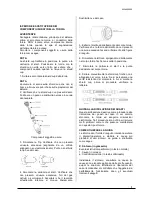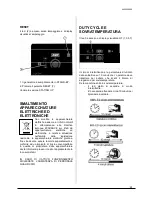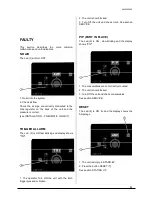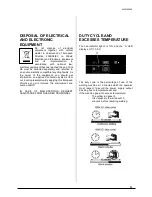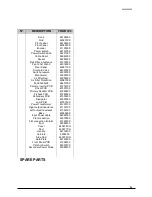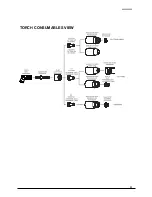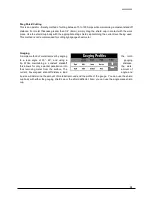
6934900000
18
PREVENTIVE MAINTENANCE OF POWER
SOURCE.
ALWAYS DISCONNECT INPUT PRIMARY
SUPPLY!!!
Inspect the inside of the POWER SOURCE
INVERTER from time to time (every 3-4 weeks
depending on usage and environment), removing
the deposits of dust from the inside parts so that
their cooling and operation is not impeded. The
frequency of this operation depends on the
position of the machine and on the quantity of dust
and deposits in the working atmosphere.
Frequently check that the power cables and
connections are securely fastened.
CHANGING WORN PARTS
Attention!
The
torch
nozzle
and
the
neighbouring parts reach high temperatures
during use; to avoid the risk of burns, wait for
them to cool down before carrying out
maintenance work!
From time to time, or if you notice any
malfunctions, inspect the torch nozzle to see
whether there is any damage. If the nozzle hole is
deteriorated or appears to be oval, it is time to
change the spare parts.
Inspect the electrode: if the centre of the electrode
has a cavity deeper than 1.5 mm, change it.
No particular tools are needed to change the torch
parts. Just unscrew the closing cap and all the
torch components can be easily replaced. When
you unscrew the cap you hear a slight click due to
a micro switch which disables the machine so as to
avoid accidental starts. Once the torch is in order,
to start work again you must press the RESET
button.
SPECIAL MAINTENANCE
For any special maintenance jobs, it is essential to
have the necessary technical knowledge and
suitable equipment. Otherwise apply to the nearest
assistance centre.
SERVICE
This
section
describes
basic
maintenance
procedures performable by operating personnel.
No other adjustments or repairs are to be
attempted
by
other
than
properly
trained
personnel.
WARNING:
ALWAYS
DISCONNECT
INPUT
PRIMARY
SUPPLY!!!
Disconnect primary power at the source before
disassembling of torch leads.
Frequently review the important safety precautions
at the front of this Manual. Be sure the operator is
equipped with proper gloves, clothing, eye and ear
protection. Make sure no part of the operator’s
body comes into contact with the work-piece while
the torch is active.
CAUTION
Sparks from the cutting process can cause
damage to coated, painted, and other surfaces
such as glass, plastic and metal.
GENERAL TORCH MAINTENANCE
-
A. Cleaning Torch
Even when precautions are taken to use only clean
air with a torch, eventually the inside of the torch
becomes coated with residue. This build-up can
affect the pilot arc initiation and the overall cut
quality of the torch.
WARNING.
ALWAYS
DISCONNECT
INPUT
PRIMARY
SUPPLY!!!
Disconnect primary power to the system before
disassembling the torch or torch leads.
DO NOT touch any internal torch parts while the
AC indicator light of the power supply is ON.
The inside of the torch should be cleaned with
electrical contact cleaner using a cotton swab or
soft wet rag. In severe cases, the torch can be
removed from the leads and cleaned more
thoroughly by pouring electrical contact cleaner
into the torch and blowing it through with
compressed air.
CAUTION
Dry the torch thoroughly before reinstalling.
COMMON OPERATING FAULTS
The following lists the more common cutting faults
and possible causes:
1. Insufficient penetration
a. Cutting speed too fast
b. Torch not at 90°
c. Metal too thick
d. Worn torch parts
e. Cutting current too low
f. NON- genuine manufacturer parts
2. Cutting Arc Extinguishes
a. Cutting speeds too slow
b. Torch stand-off too high from work piece
c. Cutting current too high
d. Work cable disconnected
e. Worn torch parts
f. NON- genuine manufacturer parts
3. Excessive dross Formation
a. Cutting speeds too slow
b. Torch stand-off too high from work piece
c. Worn torch parts
d. Improper cutting current
e. NON- genuine manufacturer parts






